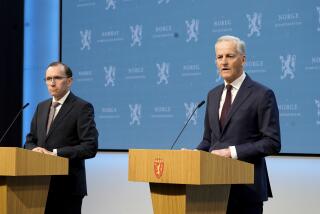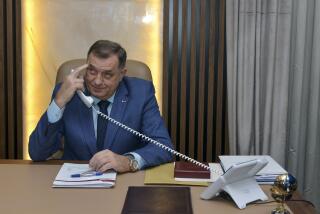U.S. Recognizes 3 Ex-Republics of Yugoslavia
- Share via
DOBOJ, Bosnia-Herzegovina — Warplanes of the Yugoslav federal army bombed Croatian strongholds in this newly independent country Tuesday as the United States officially conceded Yugoslavia’s demise by recognizing Bosnia-Herzegovina and two other republics that seceded last June.
Serbian radicals, angered by the growing international acceptance of independence for former Yugoslav republics, declared that they are forming their own state around the guerrilla-held Bosnian city of Banja Luka. Armed gangs also tightened control over other occupied areas of the violence-racked republic.
The U.S. decision to recognize Bosnia-Herzegovina, Croatia and Slovenia put American foreign policy in the troubled Balkans on course with European allies and shattered what has been an appearance of condoning Serbian aggression in order to keep the Yugoslav federation together.
“Today, the United States is recognizing the independence of three new states, formerly republics of Yugoslavia,” Secretary of State James A. Baker III announced in Washington.
Standing behind the international view that borders should not be forcibly changed, Baker declared that the United States “accepts the pre-crisis republic borders as the legitimate international borders of Bosnia-Herzegovina, Croatia and Slovenia.”
Serbian militants have conquered and occupied one-third of breakaway Croatia and large areas of Bosnia-Herzegovina, demanding that the regions be linked to the Serbian remnants of Yugoslavia.
With 50 other countries having already recognized Slovenia and Croatia, the United States was the last major power to accept the breakup of Yugoslavia, a multiethnic federation that has often been at war with itself since its U.S.-brokered formation in 1918.
“Since the conflict erupted in the middle of 1991 in Yugoslavia, our overriding concern has been to end hostilities,” a Bush Administration official said in explaining the U.S. policy reversal.
Baker’s announcement came as Serbian nationalists reacted angrily to European Community recognition of Bosnia-Herzegovina a day earlier. They shelled the capital, Sarajevo, and sealed off Serbian-controlled regions with armed roadblocks.
In an ominous sign that federal armed forces are taking the side of the militant Serbs, fighter planes of the Yugoslav People’s Army attacked at least three sites in the southwest, inhabited mostly by Croats.
Sarajevo Radio reported five people killed in a dawn missile attack on the town of Siroki Brijeg, and the Belgrade-based Tanjug news agency confirmed two other air strikes against the Croatian towns of Citluk and Listica. Tanjug said the raids were directed at military targets.
About 150,000 federal troops are bottled up in Bosnia-Herzegovina after having retreated from battles waged last year in Slovenia and Croatia.
Bosnia-Herzegovina is home to some of Yugoslavia’s largest munitions factories, and financial support from the republic would be needed to sustain the oversized fighting force now reduced to defending only Serbia and tiny Montenegro.
Bosnian President Alija Izetbegovic, a Muslim, accused the army’s hard-line Serbian commander in Belgrade of waging war against his once-peaceful and tolerant republic.
Although leaders of the Serbian government and the federal army have voiced support for U.N. intervention to stop the war in Croatia, they are widely believed by Western diplomats in Belgrade to have conspired to spread the conflict to Bosnia.
Many of the paramilitary bands holding territory in Bosnia are directed by guerrilla leaders from Belgrade, like underworld figure Zeljko Raznjatovic, known as Arkan, and Serbian Radical Party leader Vojislav Seselj.
At this predominantly Serbian crossroads in northern Bosnia, machine gun-wielding vigilantes wearing Serbian Orthodox and Seselj insignia controlled the movement of vehicles to the tense, Serbian-held regions to the west and north.
Hundreds of Muslims, mostly women and children, streamed from villages near the Serbian enclaves, waiting for buses or relatives to take them to safety in other areas of the republic.
“The Serbs want our village now. We had to get out,” cried a tearful woman named Maja, who clutched two toddlers and a plastic bag of their belongings as she fled on foot in a steady rain from the Serbian-held border region around the city of Zvornik.
Western journalists also reported seeing hundreds of cars packed with refugees fleeing the areas of the republic that came under air force fire.
Shooting was again reported in the city of Bosanski Brod, about 100 miles north of Sarajevo and 40 miles north of Doboj.
The militants controlling traffic along the main east-west highway appeared to be trying to extend the self-proclaimed Serbian republic in Banja Luka, about 70 miles west, to include this Serbian stronghold.
Two Serbian members of Sarajevo’s multiethnic leadership have resigned from the collective republic presidency to set up the separatist government in Banja Luka.
They asserted that the “Serbian Republic of Bosnia-Herzegovina” will remain part of Yugoslavia.
It wasn’t clear what territory the Serbs were laying claim to, since the Banja Luka area is divided from what remains of Yugoslavia by about 100 miles of predominantly Muslim territory.
Serbs make up 31% of Bosnia-Herzegovina’s 4.4 million people, but their political leadership in Sarajevo insists that 65% of the republic’s territory belongs to the Serbs.
Fighting that has claimed as many as 200 lives in Bosnia-Herzegovina over the last week has taken place largely in Serbian communities, where the paramilitary guerrillas chased out other ethnic groups after accusing them of unspecified repression of the majority Serbs.
Officials of Bosnian President Izetbegovic’s predominantly Muslim party said over the weekend that Serbian vigilantes had executed 27 Muslim residents of the town of Bijeljina. Izetbegovic accused the federal army, which is heavily deployed around Bijeljina, of doing nothing to prevent the massacre.
In announcing recognition of the three former Yugoslav republics, a White House statement said the United States will take an active role in discussing the future of a reduced Yugoslav federation uniting Serbia and Montenegro.
Of the six former Yugoslav republics, Macedonia’s fate remains most uncertain. The republic has met all conditions for independence set by the 12-nation European Community, but Greece objects to recognition of a republic bearing the same name as its northern province.
Washington also indicated that it would work “intensively and extensively” with the EC to resolve the Macedonian standoff.
In conjunction with its recognition of Bosnia-Herzegovina, announced Monday, EC foreign ministers lifted an economic blockade of Serbia imposed last year when the Belgrade government was accused of provoking war in Croatia.
The White House lifted economic sanctions from all of the Yugoslav republics except for Serbia and Montenegro, reversing another position that sanctions should be applied to all six republics or none of them.
Times staff writer Norman Kempster in Washington contributed to this article.
More to Read
Sign up for Essential California
The most important California stories and recommendations in your inbox every morning.
You may occasionally receive promotional content from the Los Angeles Times.














